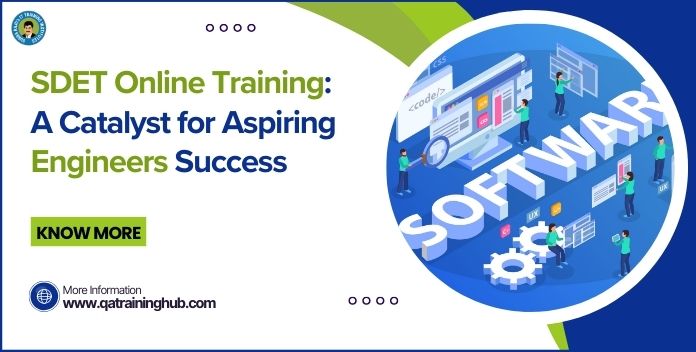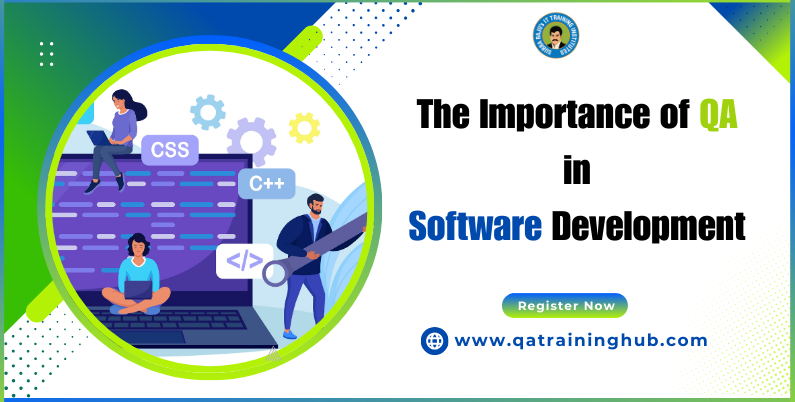Learn the Core SDLC Methodologies with Subba Raju Sir at QA Training Hub

Methodologies of Software Development Life Cycle (SDLC)
The Software Development Life Cycle (SDLC) is a systematic process that software teams follow to develop, test, deploy, and maintain software applications. Choosing the right SDLC methodology is critical for project success, as it determines how well the software aligns with business goals, timelines, and budgets. In this blog, we will explore the most popular methodologies of SDLC: Waterfall, Incremental, V-Model, Spiral, and Agile, highlighting their features, advantages, and ideal use cases. The Software Development Life Cycle (SDLC) serves as a roadmap for systematically designing, building, and delivering high-quality software. It encompasses a series of well-defined stages, such as planning, designing, development, testing, and deployment, ensuring that software meets user requirements and business objectives. To execute these stages effectively, various Methodologies of Software Development Life Cycle (SDLC) have been developed over time, each catering to specific project needs and challenges. From the structured Waterfall Model to the flexible Agile Approach, each methodology offers unique advantages.
In this blog, we’ll dive into the five most prominent SDLC methodologies—Waterfall, Incremental, V-Model, Spiral, and Agile—to help you understand their characteristics, benefits, and ideal use cases. Whether you’re a beginner or an experienced professional, mastering these approaches is essential for navigating today’s dynamic software development landscape.
SDLC Methodologies:
-
Waterfall Model
The Waterfall Model is a linear and sequential approach where each phase of the SDLC must be completed before moving on to the next. The Waterfall Model is one of the earliest and most straightforward approaches in software development. It follows a linear and sequential structure, where each phase must be completed before the next begins. The process starts with gathering and documenting comprehensive requirements, which are then followed by the design phase, implementation or coding, testing, deployment, and finally, maintenance. This Methodologies of Software Development Life Cycle (SDLC) is characterized by its rigid framework, where revisiting earlier stages is not allowed without starting the process over.
One of the primary advantages of the Waterfall Model is its simplicity and clarity. Each phase has distinct goals and deliverables, making it easy to manage and track progress. It is especially effective for projects with fixed and well-understood requirements, such as government or enterprise systems with little room for changes. However, its rigidity can be a drawback for projects with evolving requirements or unforeseen changes, as the late testing phase may lead to costly corrections if defects are found. Despite its limitations, the Waterfall Model remains a valuable approach for projects where stability, structure, and thorough documentation are prioritized.
Key Features:
- Rigid structure with defined stages: Requirements, Design, Implementation, Testing, Deployment, and Maintenance.
- Each stage has specific deliverables and a review process.
Advantages:
- Easy to manage due to its structured nature.
- Works well for projects with well-defined requirements.
- Clear documentation at each phase.
Disadvantages:
- Not suitable for projects with changing requirements.
- Testing occurs late in the cycle, increasing the risk of costly rework.
Ideal Use Cases:
- Projects with fixed requirements and minimal scope for change.
- Regulatory or compliance-heavy industries.
-
Incremental Model
The Incremental Model divides the project into smaller, manageable modules that are developed and delivered in increments. The Incremental Model is an Methodologies of Software Development Life Cycle (SDLC) that divides the development process into smaller, manageable parts called increments. Each increment undergoes the entire development cycle—planning, design, development, testing, and deployment—and adds a functional piece to the overall system. This approach allows for early delivery of critical features, enabling stakeholders to see tangible results and provide feedback before the entire project is completed. The model is highly flexible, making it easier to accommodate changes and refinements after each increment. Additionally, risks are reduced as issues can be identified and resolved during early iterations. However, success with the Incremental Model requires careful planning to ensure seamless integration between increments. It is especially beneficial for projects where quick delivery of essential functionality is required or when requirements are expected to evolve during development.
Key Features:
- Each increment adds a specific set of features.
- Feedback from earlier increments helps refine subsequent iterations.
Advantages:
- Early delivery of functional software.
- Easier to identify and address risks early.
- Accommodates changes between increments.
Disadvantages:
- Requires careful planning and modular design.
- Integration issues may arise if increments are not aligned.
Ideal Use Cases:
- Medium-sized projects with dynamic requirements.
- Projects that need quick delivery of critical features.
-
V-Model (Verification and Validation Model)
The V-Model is an extension of the Waterfall Model with an emphasis on testing at every stage of development. The V-Model, also known as the Verification and Validation Model, is an extension of the traditional Waterfall methodology, with a primary focus on quality through rigorous testing. In this model, every development phase has a corresponding testing phase, forming a V-shaped sequence that represents the flow of activities. For instance, requirements are validated through acceptance testing, design is verified through system testing, and so on. This dual focus ensures that potential defects are identified and addressed early in the development cycle, significantly reducing costs associated with later-stage corrections.
One of the key strengths of the V-Model is its structured Methodologies of Software Development Life Cycle (SDLC) approach to testing, which makes it highly suitable for projects where reliability and accuracy are critical, such as in healthcare, aerospace, and automotive industries. However, the rigid nature of this methodology means it works best for projects with clearly defined requirements and minimal scope for changes. While it may lack flexibility, its emphasis on validation at every step makes it an ideal choice for delivering high-quality software solutions in complex and regulated environments.
Key Features:
- Testing activities are planned in parallel with development phases.
- A corresponding test phase exists for each development stage.
Advantages:
- High-quality output due to early and continuous testing.
- Defects are identified early, reducing overall cost.
Disadvantages:
- Rigid structure, making it less adaptable to changes.
- Suitable only for projects with clearly defined requirements.
Ideal Use Cases:
- Safety-critical systems like medical devices or aerospace applications.
- Projects with comprehensive testing requirements.
-
Spiral Model
The Spiral Model combines iterative development with risk management, emphasizing early identification and mitigation of risks. The Spiral Model is a sophisticated Methodologies of Software Development Life Cycle that blends the iterative nature of prototyping with the systematic aspects of the Waterfall Model, placing a strong emphasis on risk analysis and management. The development process in this model is represented as a spiral, with each loop signifying a phase of the project. These loops are divided into four key activities: planning, risk analysis, engineering (design and development), and evaluation. By revisiting these phases in each spiral, the model ensures that risks are identified and mitigated early, reducing the likelihood of costly errors during later stages.
This approach is highly flexible, allowing teams to incorporate changes based on client feedback or evolving requirements after every iteration. It is especially suited for large, complex, and high-risk projects, such as those in aerospace, defense, or financial sectors, where the stakes are high and requirements often evolve over time. However, its emphasis on risk analysis and iterative development requires experienced teams and can be resource-intensive. Despite this, the Spiral Model remains a preferred choice for projects where minimizing risk and maximizing adaptability are paramount.
Key Features:
- Development progresses through repeated cycles or “spirals.”
- Each spiral includes planning, risk analysis, engineering, and evaluation.
Advantages:
- High flexibility to adapt to changes.
- Risk is actively managed at each iteration.
- Suitable for large and complex projects.
Disadvantages:
- High cost and complexity due to extensive risk analysis.
- Requires expertise in risk management.
Ideal Use Cases:
- Large-scale, high-risk projects.
- Applications requiring significant user input during development.
-
Agile Model
The Agile Model prioritizes flexibility, collaboration, and customer satisfaction by delivering software in small, iterative cycles called sprints. The Agile Model is a dynamic and iterative approach to software development, designed to accommodate the fast-paced and ever-changing demands of modern projects. Unlike traditional models that follow a linear process, Agile emphasizes collaboration, adaptability, and customer satisfaction by delivering working software in short, manageable cycles called sprints. These sprints typically last 2–4 weeks, ensuring continuous delivery of functional modules and enabling regular feedback from stakeholders.
Agile encourages close collaboration between cross-functional teams, including developers, testers, designers, and clients, fostering a shared understanding of project goals. It thrives on adaptability, allowing teams to reprioritize tasks or adjust to changing requirements without disrupting the development flow. Testing and validation occur concurrently with development, ensuring high-quality deliverables at every stage.
By focusing on delivering value incrementally, the Agile Model minimizes risks and enhances user satisfaction, making it particularly effective for startups, businesses with evolving requirements, and projects requiring quick time-to-market. Popular frameworks like Scrum, Kanban, and Extreme Programming (XP) are widely used under the Agile umbrella, further showcasing its versatility and effectiveness in various scenarios.
Key Features:
- Adaptive planning and continuous feedback.
- Cross-functional teams work closely with stakeholders.
- Focus on delivering functional software at the end of each sprint.
Advantages:
- Rapid response to changes.
- Encourages customer involvement throughout the process.
- High-quality deliverables due to regular testing and reviews.
Disadvantages:
- Requires a highly skilled and collaborative team.
- Less focus on comprehensive documentation.
Ideal Use Cases:
- Dynamic projects with evolving requirements.
- Startups or businesses requiring quick time-to-market.
Choosing the Right Methodologies of Software Development Life Cycle (SDLC):
Each SDLC methodology has its strengths and weaknesses. The choice depends on factors such as project size, complexity, budget, and the likelihood of changing requirements.
For example:
- Use Waterfall for stable and well-defined projects.
- Choose Agile for projects requiring flexibility and speed.
- Opt for Spiral if risk management is a priority.
- Consider Incremental for phased delivery.
- Leverage V-Model for high-quality, test-intensive applications.
Conclusion
Understanding the Methodologies of Software Development Life Cycle (SDLC) is crucial for effective project planning and execution. Whether you’re a beginner exploring SDLC or an experienced professional refining your approach, each methodology offers unique insights and solutions for software development challenges.
Start mastering SDLC methodologies today with QA Training Hub, where industry experts provide in-depth training to elevate your software development expertise.




